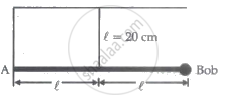Advertisements
Advertisements
प्रश्न
Assume that a tunnel is dug along a chord of the earth, at a perpendicular distance R/2 from the earth's centre where R is the radius of the earth. The wall of the tunnel is frictionless. (a) Find the gravitational force exerted by the earth on a particle of mass mplaced in the tunnel at a distance x from the centre of the tunnel. (b) Find the component of this force along the tunnel and perpendicular to the tunnel. (c) Find the normal force exerted by the wall on the particle. (d) Find the resultant force on the particle. (e) Show that the motion of the particle in the tunnel is simple harmonic and find the time period.
उत्तर

If \[\rho\] is the density of the earth, then mass of the earth \[\left( M \right)\] is given by,
\[M = \frac{4}{3}\pi R^3 \rho\]
\[\text {Similarly, mass} \left( M' \right) \text{ of the part of earth having radius } \left( x \right)\text{ is given by, } \] \[M' = \frac{4}{3}\pi {x_1}^3 \rho\]
\[M' = \left( \frac{M}{R^3} \right) {x_1}^3\]
(a) Let F be the gravitational force exerted by the earth on the particle of mass m. Then, its value is given by,
\[F = \frac{GM'm}{x_1^2}\]
\[\text {Substituting the value of M' in the above equation, we get: }\]
\[F = \frac{GMm}{R^3}\frac{x_1^3}{x_1^2}\]
\[ = \frac{GMm}{R^3} x_1 = \frac{GMm}{R^3}\sqrt{x^2 + \left( \frac{R^2}{4} \right)}\]
(b)
\[F_y = Fcos\theta\]
\[ = \frac{GMm x_1}{R^3}\frac{x}{x_1} = \frac{GMmx}{R^3}\]
\[ F_x = F\sin \theta\]
\[ = \frac{GMm x_1}{R^3}\frac{R}{2 x_1} = \frac{GMm}{2 R^2}\]
(c) 
\[F_x = \frac{GMm}{R^2}\]
\[\because\] Normal force exerted by the wall N = Fx
(d)The resultant force is \[\frac{GMmx}{R^3}\]
(e) Acceleration = Driving force/mass
\[= \frac{GMmx}{R^3 m}\]
\[ = \frac{GMx}{R^3}\]
\[\Rightarrow\] a \[\propto\] x (the body executes S.H.M.)
\[\frac{a}{x} = \omega^2 = \frac{GM}{R^3}\]
\[ \Rightarrow \omega = \sqrt{\frac{Gm}{R^3}}\]
\[ \Rightarrow T = 2\pi\sqrt{\frac{R^3}{GM}}\]
APPEARS IN
संबंधित प्रश्न
Can a pendulum clock be used in an earth-satellite?
The force acting on a particle moving along X-axis is F = −k(x − vo t) where k is a positive constant. An observer moving at a constant velocity v0 along the X-axis looks at the particle. What kind of motion does he find for the particle?
The average energy in one time period in simple harmonic motion is
A particle moves in a circular path with a continuously increasing speed. Its motion is
Which of the following quantities are always positive in a simple harmonic motion?
Which of the following quantities are always zero in a simple harmonic motion?
(a) \[\vec{F} \times \vec{a} .\]
(b) \[\vec{v} \times \vec{r} .\]
(c) \[\vec{a} \times \vec{r} .\]
(d) \[\vec{F} \times \vec{r} .\]
In a simple harmonic motion
A particle executes simple harmonic motion with an amplitude of 10 cm and time period 6 s. At t = 0 it is at position x = 5 cm going towards positive x-direction. Write the equation for the displacement x at time t. Find the magnitude of the acceleration of the particle at t = 4 s.
A pendulum having time period equal to two seconds is called a seconds pendulum. Those used in pendulum clocks are of this type. Find the length of a second pendulum at a place where g = π2 m/s2.
A uniform rod of length l is suspended by an end and is made to undergo small oscillations. Find the length of the simple pendulum having the time period equal to that of the road.
Three simple harmonic motions of equal amplitude A and equal time periods in the same direction combine. The phase of the second motion is 60° ahead of the first and the phase of the third motion is 60° ahead of the second. Find the amplitude of the resultant motion.
In a simple harmonic oscillation, the acceleration against displacement for one complete oscillation will be __________.
The length of a second’s pendulum on the surface of the Earth is 0.9 m. The length of the same pendulum on the surface of planet X such that the acceleration of the planet X is n times greater than the Earth is
A simple pendulum is suspended from the roof of a school bus which moves in a horizontal direction with an acceleration a, then the time period is
A simple harmonic motion is given by, x = 2.4 sin ( 4πt). If distances are expressed in cm and time in seconds, the amplitude and frequency of S.H.M. are respectively,
A spring is stretched by 5 cm by a force of 10 N. The time period of the oscillations when a mass of 2 kg is suspended by it is ______
The displacement of a particle is represented by the equation `y = 3 cos (pi/4 - 2ωt)`. The motion of the particle is ______.
The displacement of a particle varies with time according to the relation y = a sin ωt + b cos ωt.
A weightless rigid rod with a small iron bob at the end is hinged at point A to the wall so that it can rotate in all directions. The rod is kept in the horizontal position by a vertical inextensible string of length 20 cm, fixed at its midpoint. The bob is displaced slightly, perpendicular to the plane of the rod and string. The period of small oscillations of the system in the form `(pix)/10` is ______ sec. and the value of x is ______.
(g = 10 m/s2)

